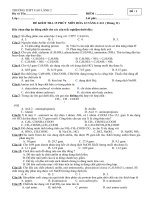Ch 3 3 sedimentary rocks
Bạn đang xem bản rút gọn của tài liệu. Xem và tải ngay bản đầy đủ của tài liệu tại đây (959.93 KB, 15 trang )
Warm Up 10/4
1. The igneous rock texture that is characterized by two distinctly
different crystal sizes is called ____.
a. porphyritic texture c. fine-grained texture
b. glassy texture
d. coarse-grained texture
2. Igneous rocks that crystallize from magma and are composed
almost entirely of quartz and feldspars have a(n) ____.
a. andesitic composition
c. ultramafic composition
b. basaltic composition
d. granitic composition
3. A rock that forms when magma hardens beneath Earth’s
surface is called an ____.
a. intrusive metamorphic rock
b. extrusive igneous rock
c. intrusive igneous rock
d. extrusive sedimentary rock
Answers: 1) a. 2) d. 3) c.
Sedimentary Rocks
Chapter 3, Section 3
Weathering, Erosion, and Deposition
• Weathering is any process which breaks rocks
into sediments
• Erosion involves weathering and the removal of
rock. When an agent of erosion – water, wind,
or gravity – loses energy, it drops the
sediments. This process is called deposition.
• Sediments are deposited according to size.
• Smaller sediments will travel longer distances
Weathering, Erosion, and
Deposition
Compaction and Cementation
• Compaction and cementation change
sediments into sedimentary rocks
• Compaction is a process that squeezes,
or compacts, sediments
• Compaction is caused by the weight of
sediments
• Cementation takes place when dissolved
minerals are deposited in the tiny spaces
among the sediments.
Compaction and Cementation
Concept Check
• What are the five major processes
involved in the formation of sedimentary
rocks?
• Weathering, erosion, deposition,
compaction, and cementation
Classification of Sedimentary
Rocks
• Just like igneous rocks, sedimentary rocks
can be classified into two main groups
according to the way they form.
• Clastic Sedimentary Rocks – rocks that
are made of the weathered bits of rocks
and minerals
• Chemical Sedimentary Rocks – forms
when dissolved minerals precipitate from
water solutions
Clastic vs. Chemical Sedimentary
Rocks
Chemical Sedimentary Rocks
Clastic Sedimentary Rocks
Formation of
Coal
Concept Check
• What are the major types of clastic
sedimentary rocks?
• Conglomerates and breccia, sandstone,
shale and siltstone
Sedimentary Rock Features
• The many unique features of sedimentary rocks
are a clue to how, when, and where the rocks
formed.
• Each layer of sedimentary rocks records a
period of sedimentation
• The oldest layers are found at the bottom and
the youngest layers are found at the top
• Some fossils are unique to certain sedimentary
rocks; they can answer questions as to where
that rock formed and how old they are
Sedimentary Rock Features
Assignment
• Read Chapter 3, Section 3 (pg. 75-79)
• Do Section 3.3 Assessment #1-9 (pg. 79)
• Print out “Exploration Lab 3 – Rock
Identification” for next class!









